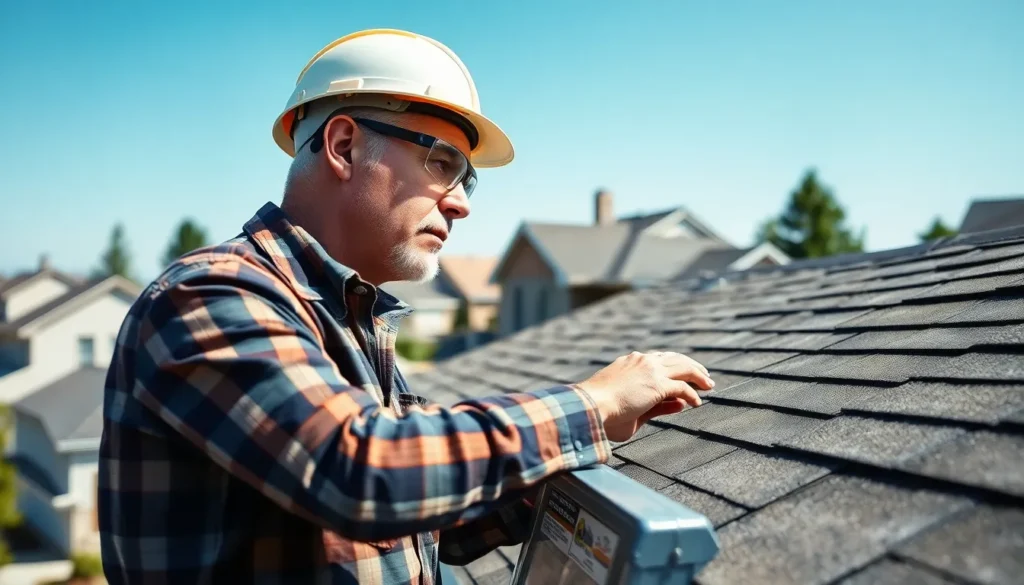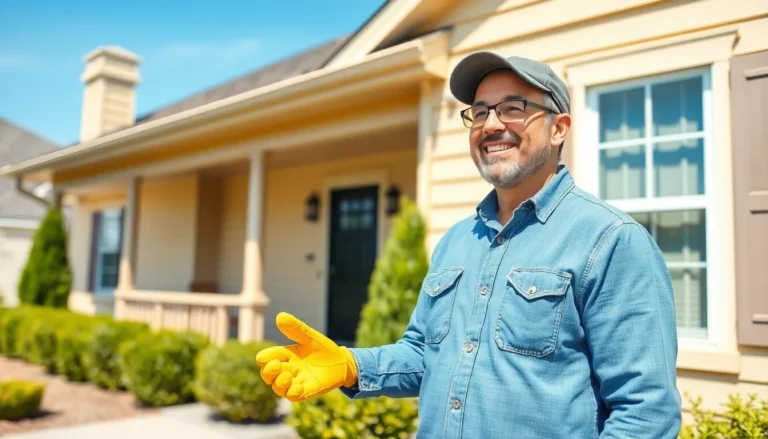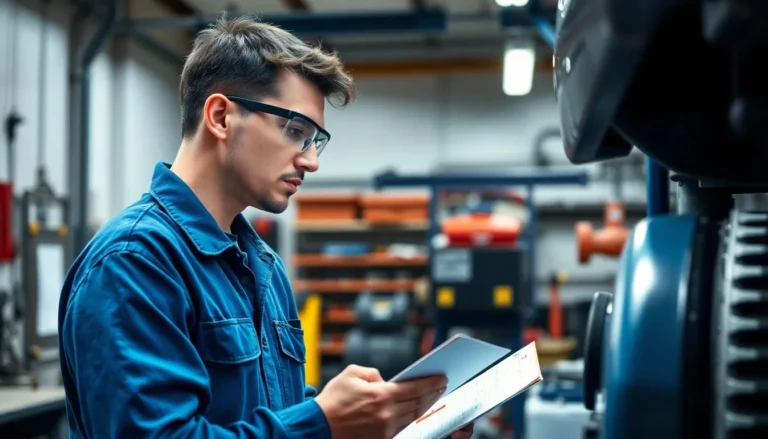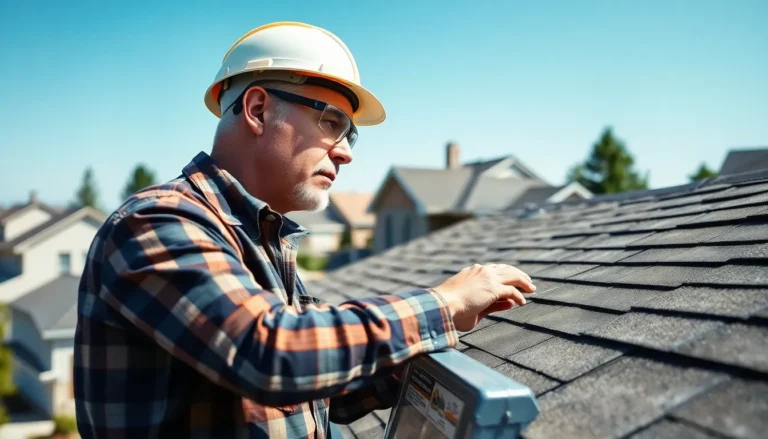A well-maintained roof is crucial for any home, protecting it from the elements and ensuring its longevity. Regular roof inspections can save homeowners from costly repairs down the line. By identifying potential issues early, they can address problems before they escalate, safeguarding their investment and enhancing their home’s value.
Many overlook the importance of roof inspections, assuming their roofs are in good shape. However, weather conditions, age, and other factors can lead to hidden damage. Understanding the benefits of routine inspections empowers homeowners to take proactive steps in maintaining their roofs. With the right knowledge, they can keep their homes safe and secure for years to come.
Table of Contents
ToggleWhat Is Roof Inspection?
Roof inspection involves a thorough examination of a roof’s condition to identify any damage, wear, or potential issues. This process generally includes checking roofing materials, flashing, gutters, and structural components. Professionals often perform these inspections either as part of routine maintenance or when preparing to sell a property.
Inspectors assess various elements:
- Materials: Inspectors check shingles, tiles, or membranes for signs of wear or damage.
- Flashing: This metal strip prevents water leakage at joints and angles, which inspectors ensure is properly sealed.
- Gutters: Inspectors evaluate gutter conditions and functionality to guarantee proper drainage.
- Structural Integrity: The overall structure, including rafters and trusses, undergoes scrutiny for stability and safety.
Identifying roof problems early through inspections can lower repair costs and extend a roof’s lifespan. Regular assessments help maintain structural integrity and protect homes from environmental harm. Engaging professional roofers or certified inspectors ensures comprehensive evaluations, leading to timely repairs and enhanced property value.
Importance Of Roof Inspection
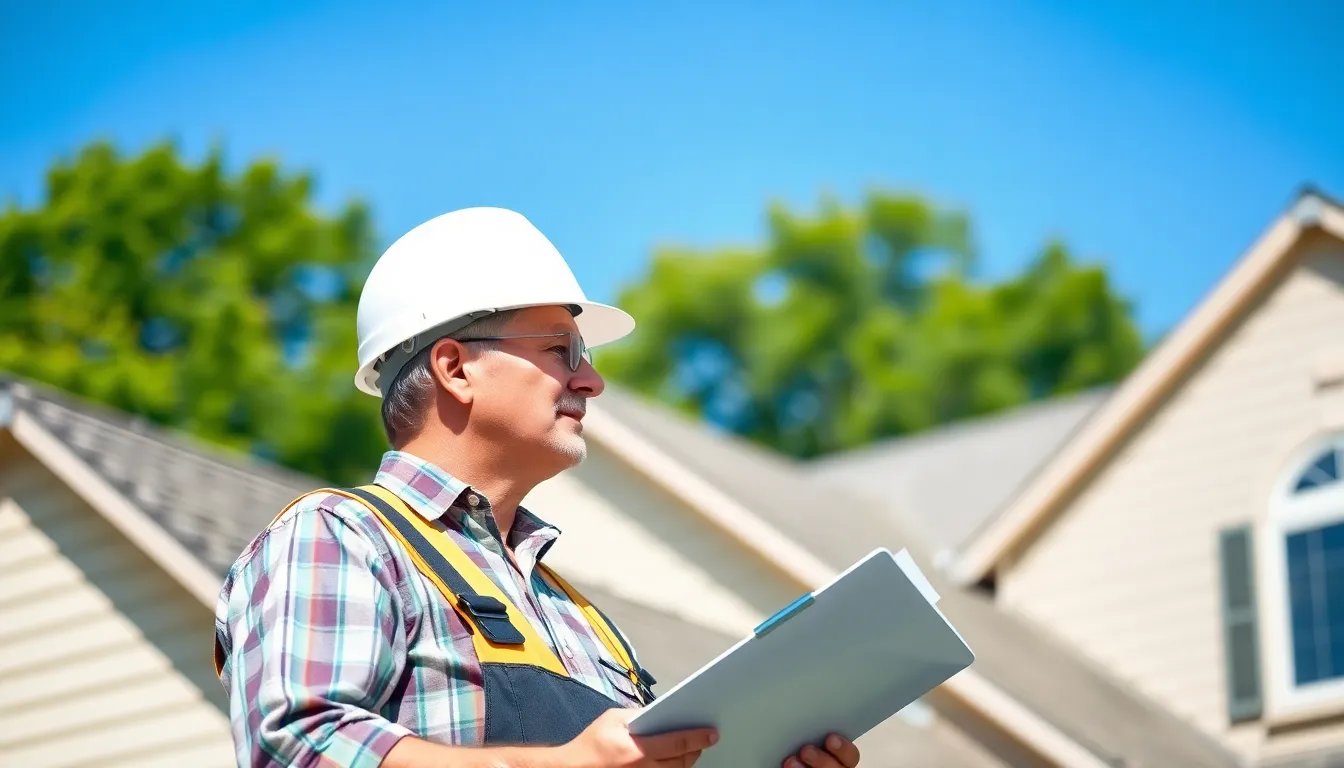
Regular roof inspections play a crucial role in maintaining a home’s integrity and value. These inspections not only identify existing problems but also prevent future issues that may arise.
Preventing Expensive Repairs
Routine roof inspections help detect early signs of damage, such as leaks, missing shingles, or compromised flashing. Identifying these issues promptly allows homeowners to address them before they escalate into more significant problems. Homeowners can save thousands in repair costs by catching minor damage early, ensuring that the roof remains intact and functional. Regular inspections often uncover hidden concerns, preventing last-minute emergencies and giving homeowners peace of mind.
Enhancing Property Value
A well-maintained roof significantly contributes to a home’s overall value. Prospective buyers often look for roofs in good condition, as they indicate proper upkeep. Roof inspections help maintain that condition by providing an accurate assessment of the roof’s health. Homeowners can use inspection reports as a selling point, showcasing regular maintenance to potential buyers. Investing in routine inspections not only preserves property value but can also lead to quicker sales and potentially higher offers.
Signs That Indicate The Need For Inspection
Homeowners should remain vigilant for specific signs that indicate a roof inspection is necessary. Detecting these signs early can prevent extensive damage and maintain the roof’s integrity.
Visual Signs To Look For
- Missing Shingles: Shingles often come loose or fall off due to wear and tear. Missing shingles expose underlying layers, leading to potential leaks.
- Curling or Buckling: Shingles that curl or buckle indicate aging or improper installation. This condition can compromise the roof’s durability and aesthetics.
- Granule Loss: Loss of granules from shingles can signal deterioration. Check gutters for excessive granules, as they contribute to waterproofing.
- Dark Spots or Stains: Discoloration may point to water damage or mold. These stains can spread and weaken roofing materials over time.
- Cracks and Blisters: Cracks or blisters in shingles suggest moisture infiltration. These defects can reduce a roof’s lifespan significantly.
- Damaged Flashing: Flashing around chimneys and vents must remain intact. Damage may cause leaks and necessitates immediate inspection.
After Severe Weather Events
- Leaking or Water Damage: Post-storm inspections are crucial. Leaks or water stains inside the home reveal potential roof damage.
- Debris Accumulation: Accumulated debris, like branches and leaves, can obstruct drainage and lead to water pooling, increasing leak risks.
- Structural Damage: Significant weather events can compromise the structural integrity. Homeowners should inspect for sagging or visible shifts in the roofline.
- Ice Dams: Ice accumulation in winter, known as ice dams, can damage roofing materials and lead to leaks. Inspect for ice buildup after winter storms.
- Wind Damage: High winds can displace rooftops or loosen shingles. Check for visible signs of wind damage on nearby structures and landscaping.
The Roof Inspection Process
The roof inspection process involves a systematic approach to assessing a roof’s condition. Inspectors utilize specific tools and follow a step-by-step guide to ensure a thorough evaluation.
Tools And Equipment Needed
Inspectors rely on several tools and equipment to conduct a comprehensive roof inspection:
- Ladder: A sturdy extension ladder for reaching high areas safely.
- Flashlight: A bright flashlight to illuminate dark areas and find hidden damage.
- Moisture Meter: An instrument to measure moisture levels within roofing materials.
- Binoculars: Binoculars help inspect hard-to-reach areas from the ground, revealing surface conditions.
- Roofing Safety Gear: Safety harnesses, helmets, and non-slip footwear protect inspectors during heights.
- Camera: A camera documents conditions and damage for records and recommendations.
Equipped with these tools, inspectors can accurately assess the roof’s condition and identify necessary repairs.
Step-By-Step Inspection Guide
A structured approach ensures a thorough roof inspection. Follow these steps:
- Safety Check: Inspectors review safety equipment and ensure ladders are stable.
- Visual Assessment: A preliminary visual inspection from the ground identifies obvious damage or missing shingles.
- Climb the Roof: Inspectors ascend the roof for closer inspection of shingles, flashing, and gutters.
- Check for Damage: Inspectors examine for curling, buckling, or missing shingles and assess flashing for wear.
- Inspect Gutters and Downspouts: They evaluate gutter functionality and clear any blockages.
- Look for Water Damage Indicators: Inspectors check for signs like stains or mold, indicating potential leaks.
- Evaluate Structural Components: Inspect overall structural integrity, including supports and underlayment.
- Document Findings: Inspectors take photographs and note issues, recommending repairs as necessary.
Following this guide ensures thorough and effective roof inspections, enabling identification of issues before they escalate into larger problems.
Hiring A Professional Inspector
Engaging a professional inspector ensures a detailed evaluation of the roof’s condition. Homeowners benefit from the expertise of certified professionals who understand the complexities of roofing systems.
What To Look For In A Professional
- Certification: Select inspectors with proper certifications from recognized organizations, such as the National Roofing Contractors Association (NRCA) or the Roofing Inspection Institute (RII).
- Experience: Choose inspectors with several years of industry experience to ensure they can identify diverse roofing issues.
- Insurance: Verify that the inspector holds liability insurance and workers’ compensation coverage. This protects homeowners from potential liabilities during the inspection.
- References: Request references from previous clients to assess the inspector’s reliability and quality of service.
- Detailed Reports: Look for inspectors who provide comprehensive, written reports detailing findings and recommendations to facilitate informed decision-making.
Questions To Ask Before Hiring
- What is your inspection process? Understand the steps involved to ensure a thorough examination of the roof’s condition.
- How long will the inspection take? Get an estimate of the time required to complete the inspection for better scheduling.
- Can you provide a written estimate? Request a formal estimate for clarity on costs associated with the inspection.
- What specific issues do you look for? Inquire about the type of problems the inspector will identify during the assessment.
- Do you offer follow-up services? Confirm if the inspector provides recommendations for repairs or follow-up inspections based on the findings.
Regular roof inspections are vital for maintaining a home’s integrity and value. By identifying potential issues early, homeowners can avoid costly repairs and ensure their roofs withstand the test of time. Engaging certified professionals for thorough evaluations not only enhances safety but also contributes to a home’s overall appeal.
Staying vigilant for signs of damage and scheduling routine inspections can save homeowners from unexpected emergencies and provide peace of mind. Ultimately, a well-maintained roof is an investment in both the property and its long-term value, making it essential for every homeowner to prioritize this crucial aspect of home maintenance.

